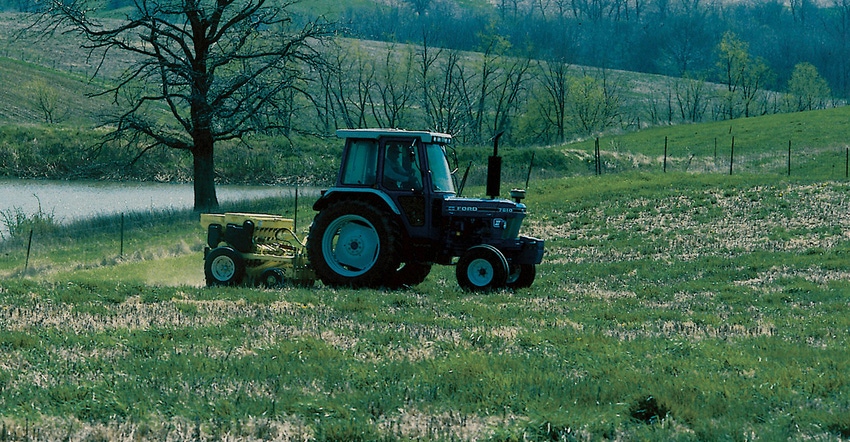March 11, 2019

By Steve Barnhart
Farmers wanting to add to or improve the forage species in their existing pastures may consider frost seeding in February and early March once the snow melts, or interseeding later in spring.
Interseeding is another way to introduce a legume or more productive grass into an existing pasture sod to improve productivity. Several precise management practices are needed for successful pasture interseeding. Likewise, certain steps must be followed to achieve success with frost seeding.
Frost seeding steps to success
Frost seeding involves spreading forage seed on existing pastures during late winter or early spring while the ground is still frozen. Freeze-thaw cycles then provide shallow coverage of the seed, which helps shield it from being washed away by early spring rains. Frost seeding is the easiest method to add new forage legumes or grasses to pastures, and is likely the least expensive method. To increase this method's success, spread seed on the thinnest pasture sod areas first, and on areas where bare soil has been exposed due to heavy grazing or disturbance.
One common misconception about frost seeding is that spreading the seed on top of snow works best. The goal of frost seeding is to get seed on bare soil. This is more effective and more safely done without snow cover.
Red clover has been the Iowa forage species of choice for frost seeding. Other legumes, such as white clover and birdsfoot trefoil, also can be frost-seeded but with less success than red clover. In general, frost seeding does not work as well with grasses.
Following a few well-researched steps will improve the success of frost seeding. Those steps, seeding rates and guidelines are available in the ISU Extension publication Improving Pasture by Frost Seeding.
Interseeding with no-till drill
Interseeding also offers an opportunity for improving pasture productivity. Interseeding involves using a no-till drill to aid in incorporating a legume or a more productive grass into an existing pasture sod. Interseeding is normally done from mid-March through early May, when soil moisture and temperature are more suitable for rapid seedling establishment.
Interseeding can be accomplished with relatively few field operations. Opening of the grass sod, shallow seed placement, and seed coverage are required. Drills are available that can be used in sod-seeding efforts. Drills vary in their effectiveness based on ability to penetrate sod, provide uniform seed depth and metering, and cover the seed furrow. Equipment limitations for sod seeding implements sometimes are overcome by operator experience with use and adjustments, and with home shop modifications.
Boost pasture yield
Legumes interseeded into grass sod should increase pasture yield, improve forage quality, and eliminate or minimize the need to apply nitrogen fertilizer. Clovers, alfalfa and birdsfoot trefoil have all been successfully interseeded. A no-till drill’s more efficient seed placement allows many of the more productive perennial forage grasses to be successfully established by interseeding. Thin, low-producing, grass sod might best be improved by interseeding a grass-legume mixture.
A seeding delay into late spring to improve growing conditions often also leads to greater competition from the existing grass sod. Close grazing in the fall or spring, ahead of interseeding, will help to reduce sod competition. Contact herbicides are sometimes also used to temporarily further reduce competition from plants present in the stand. Use only labeled herbicides for sod suppression and follow label instructions.
Interseeding success depends a lot on attention to details, timeliness, careful management of sod competition, seeding depth of no deeper than one-half inch, and a little bit of luck with weather.
Interseeding research has been conducted in many parts of the U.S. and around the world. It shouldn't come as a surprise that the conclusions from these efforts all point to several issues that must be met for success with interseeding. See ISU Extension publication Interseeding and No-Till Pasture Renovation for more regarding suggested seeding rates and guidelines.
Barnhart is a retired Iowa State University forage agronomist.
Source: ISU, which is responsible for information provided and is wholly owned by source. Informa Business Media and its subsidiaries aren’t responsible for any content in this information asset.
You May Also Like




